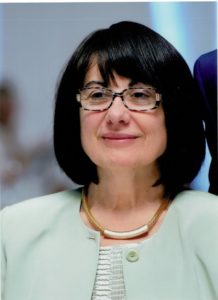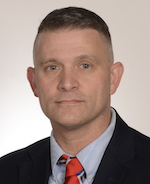Friday, May 21, 2021
12:00 pm – 1:30 pm
Panelists
Keith McManus, Co-Chair
David Petersen, Co-Chair
Sara Pozzi, Speaker and Panelist
Jasmina Vujic, Speaker
Anna Erickson, Speaker and Panelist
Bethany Goldblum, Panelist
Doug Wolfe, Speaker and Panelist
Paul Sellin, Panelist
Agenda
DTRA Academic Alliances
• Overview of DTRA Academic Alliances – 5 minutes (Dave Petersen, DTRA)
• Interaction of Ionizing Radiation with Matter (IIRM) University Research Alliance Overview – 12 minutes (Douglas Wolfe, The Pennsylvania State University)
DNN R&D Academic Consortia
• Overview of DNN R&D Academic Consortia – 5 minutes (Keith McManus, NNSA DNN R&D)
• Consortium for Enabling Technology and Innovation (ETI) Overview – 12 minutes (Anna Erickson, Georgia Institute of Technology)
• Consortium for Monitoring, Technology, and Verification (MTV) Overview- 12 minutes (Sara Pozzi, The University of Michigan)
• Nuclear Science and Security Consortium (NSSC) Overview – 12 minutes (Jasmina Vujic, The University of California, Berkeley)
Panel Discussion with Focus on Collaboration – 30 minutes
Meet the Panelists

Anna Erickson
Georgia Institute of Technology
Global nuclear energy development gives many reasons to ensure its pursuit: climate change, energy security, growth of electricity demand, and socio-political factors. While the impact is big, so are the impeding issues commonly associate with nuclear power, such as waste and proliferation and security of nuclear materials. In a fast-paced world, the approach to nuclear nonproliferation and security demands dynamic solutions. In this seminar, I will discuss the Consortium for Enabling Technologies and Innovation, representing a team of fourteen institutions of higher education (IHE) and twelve national laboratories, committed to promoting the spirit of collaborative intelligence. The unique mission of the ETI Consortium is to direct the research and innovation to enable the technologies that support the NNSA’s mission, to train the next-generation of human capital, and to bridge the gap between the university basic research and national laboratories mission-specific applications. The differentiating approach that we adopt to support the mission is to create a truly collaborative environment: the umbrella of data science to support the critical areas of enabling research of novel detectors and advanced manufacturing in nuclear nonproliferation.
Sara Pozzi
University of Michigan
Consortium for Monitoring, Technology, and Verification (MTV)
Preventing the spread of nuclear weapons is one of the central challenges facing our society today. The development of a nuclear weapons program by a state actor, or the acquisition of a nuclear device by a rogue organization, has the potential for creating domestic unrest, political instability, and economic disruption on the national and global scale. The Consortium for Monitoring, Technology, and Verification (MTV) mission is to develop new technologies that detect and deter nuclear proliferation activities and to train the next generation of nuclear professionals. The MTV also provides a strong pathway for the future NNSA workforce, launching careers within the national laboratories, government, academia, and industry.
The MTV addresses gaps and challenges in the technologies needed to monitor and verify nuclear capabilities around the world by executing research projects in close collaboration with the national laboratories. Our effort focuses on three technical thrust areas: (i) fundamentals of nuclear and particle physics, (ii) signals and source terms for nuclear nonproliferation, and (iii) nuclear explosion monitoring. Cross-cutting areas of MTV include: (1) modeling and simulation, (2) nuclear policy, and (3) education and outreach. MTV research examines the physics and chemistry of fission, discovers new relevant science, delivers advanced technologies to monitor special nuclear material at all stages of the nuclear fuel cycle, and significantly improves our ability to detect and characterize a nuclear explosion.
Jasmina Vujic
University of California, Berkeley
The Nuclear Science and Security Consortium (NSSC) is a multi-institution initiative creating a pipeline of new talent and generating fresh concepts and technologies in basic and applied nuclear science in collaboration with the national laboratories. Originally established in 2011, the NSSC was recently awarded an additional $25 million grant for a third performance period to continue this cutting-edge research and development and expand partnerships to a total of 11 universities. The next phase of the NSSC will conduct research in five focus areas organized by two main themes: fundamental nuclear sciences, which includes nuclear physics and nuclear data, nuclear chemistry and radiochemistry, and nuclear materials science; and applied nuclear science and engineering, which includes radiation detection, nuclear chemical engineering and nuclear engineering. Linking these research focus areas are two crosscutting activities: computing and optimization for nuclear applications, and education in nuclear science, technology, and policy.
The NSSC educational programming creates opportunities both within and beyond the Consortium, through the NSSC-LANL Keepin Nonproliferation Science Summer Program, an in-residence internship at Los Alamos National Laboratory, the GWU Boot Camp on Nuclear Security Policy, a nuclear policy focused summer program in Washington DC, Nuclear Security: The Nexus Between Policy and Technology, a graduate level course broadcast live from UC Berkeley, and more. With scientific excellence demonstrated through the publication of 386 peer-reviewed manuscripts, 1,321 oral and poster presentations, and nearly 200 excellence and innovation awards, the NSSC has supported 556 undergraduate and graduate students, postdocs, specialists and faculty placing 129 of these scholars into careers at DOE national laboratories or other government agencies.
Douglas Wolfe
The Pennsylvania State University[1-4]
In a world with an ever-changing nuclear landscape, applied research efforts are needed to enable the Defense Threat Reduction Agency’s (DTRA) pursuit of its mission of countering and defeating weapons of mass destruction (WMD) and threat networks. The recently established Interaction of Ionizing Radiation with Matter University Research Alliance (IIRM-URA), a DTRA sponsored basic research consortium, is tasked with advancing the understanding of material-radiation interaction, advancing radiation detection devices and their integration, and enhancing nuclear survivability and response. Penn State University leads the IIRM-URA along with three permanent members (MIT, University of Michigan, and University of Florida), eight non-permanent members, ten national laboratories and international collaborating institutions. The Alliance aims to conduct successful research by relying on physicists, chemists, materials scientists, electrical engineers, mechanical engineers, and nuclear engineers to capitalize on a multidisciplinary collaboration of personnel with diverse scientific backgrounds.
The IIRM-URA works to identify, adopt, and develop revolutionary scientific breakthroughs that will reduce, eliminate, or counter nuclear and radiological threats by investigating three research areas: 1) Materials, 2) Devices and Integration, and 3) Survival and Response. New materials and their insertions into advanced technologies are essential to DTRA’s mission to detect, deter, and defeat WMDs. Several factors accelerate such development: (i) advancing fundamental understanding of interactions of ionizing radiation with matter and harnessing such interactions; (ii) leveraging new developments in materials physics and chemistry, materials genomics, and machine learning that bring new synthesis and characterization tools, new modeling and data-science techniques, and novel candidate materials classes; and (iii) integration of new material candidates into devices that demand multiple metrics (energy resolution, response time, cost, ruggedness, etc.) to be simultaneously satisfied.
Current investigations seek an advanced understanding of the fundamental physics of radiation-solid interactions via novel materials research on developing room temperature solid-state semiconductors and improving scintillator efficiency through co-doping and enhancing light capture. Development in computational materials modeling and AI-driven robotic synthesis will further drive the search for new functional computational and electronic materials. However, novel advances cannot be performance limited by: (1) radiation-induced damage of electronic readouts; (2) the speed and size of data acquisition circuitry; or (3) the ineffectiveness of data processing algorithms to extract the most relevant information. Advancements on all of these fronts will be sought by investigating materials and techniques that broadly apply across multiple detection systems. Materials developed will be coupled into real devices through investigations into photodetectors, detector electronics and signal processing, and non-volatile memory and non-traditional computational devices. Finally, the mechanisms of radiation-induced damage will be investigated through survivability testing of systems on chips, in-situ characterization of ultra-wide bandgap materials, and long-range radioactive contamination detection. Cross Cutting Research Initiatives will leverage the highly collaborative nature of this alliance-based research model to develop computational tools that can be applied to all research areas. IIRM-URA will also train the next generation workforce with several initiatives including Young Investigator Awards, Seed programs, staff rotations, NSERC internship opportunities, and college/high school challenges. This talk will give a brief highlight of current IIRM-URA research activities.
1. Metals, Ceramics, & Coating Processing Department Head Applied Research Laboratory
2. Professor of Materials Science and Engineering at The Pennsylvania State University
3. Professor of Engineering Science and Mechanics at The Pennsylvania State University
4. Professor of Nuclear Engineering at The Pennsylvania State University



